Lytham St Annes
Lytham St Annes (/ˈlɪðəm sənt ˈænz/)[1] is a seaside resort on the Fylde coast of Lancashire, England, south of Blackpool on the Ribble Estuary. The population at the 2011 census was 42,954.[2]
| Lytham St Annes | |
|---|---|
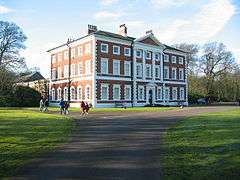 Lytham Hall | |
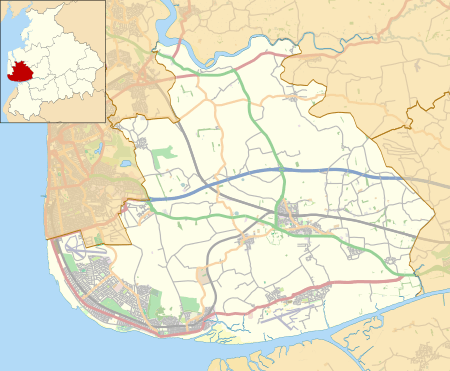 Lytham St Annes Shown within Fylde Borough 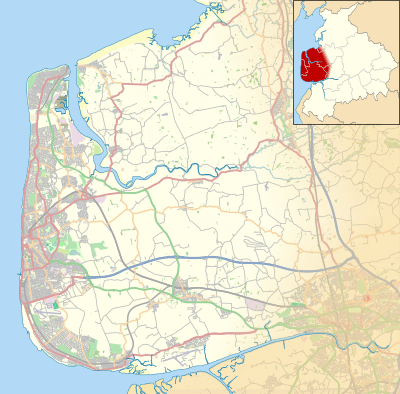 Lytham St Annes Shown within the Fylde 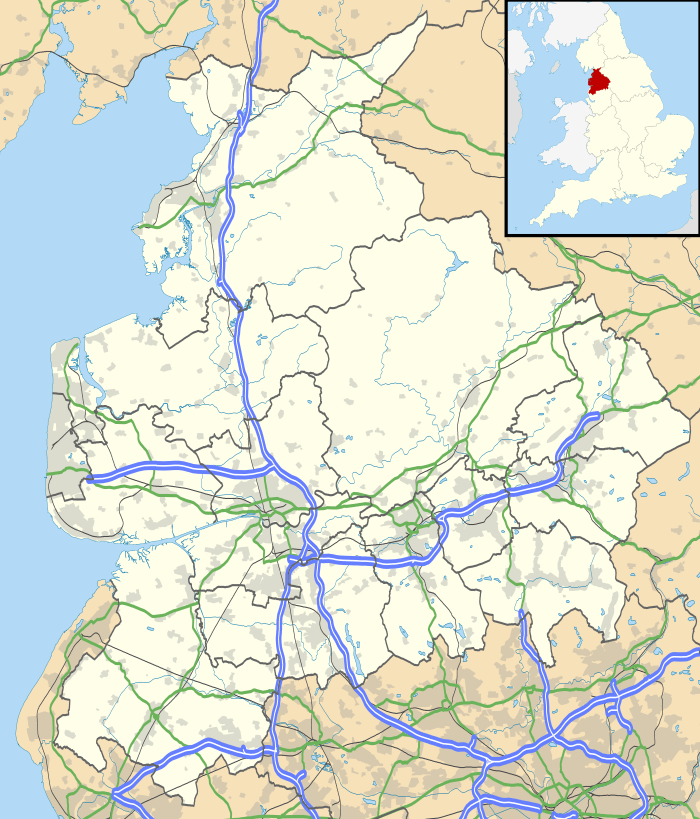 Lytham St Annes Location within Lancashire | |
| Population | 42,954 (2011) |
| OS grid reference | SD342278 |
| District | |
| Shire county | |
| Region | |
| Country | England |
| Sovereign state | United Kingdom |
| Post town | LYTHAM ST. ANNES |
| Postcode district | FY8 |
| Dialling code | 01253 |
| Police | Lancashire |
| Fire | Lancashire |
| Ambulance | North West |
| UK Parliament | |
Lytham St Annes has four golf courses and links, the most notable being the Royal Lytham & St Annes Golf Club, which has hosted the Open Championship 11 times from 1926 until its most recent in 2012. The Open brings a major influx of visitors, including the world's media.
Lytham St Annes is a reasonably affluent area with residents' earnings among the highest in the North of England.[3][4][5]
Towns and districts
Lytham St Annes consists of four main areas: Lytham, Saint Anne's-on-the-Sea, Ansdell and Fairhaven.
Lytham
Lytham was founded around 600 BC. For many centuries the economy of Lytham was dependent on fishing and shrimping, until the advent of tourism and seaside health cures. After the start of the Industrial Revolution, wealthy industrialists moved from the east of the county. Lytham's tree-lined streets are flanked by small shops, many of which are family businesses.
The Green, a strip of grass running between the shore and the main coastal road, is a notable Lytham landmark—the recently restored Windmill and Old Lifeboat House Museum are located here, and one of the sails of the Windmill was replaced in 2012. The Green overlooks the estuary of the River Ribble and the Welsh mountains. The centre of Lytham contains many notable buildings, such as the former Lytham public library, Lytham railway station, market hall, the Clifton Arms Hotel and Lytham methodist church. Some of Lytham's oldest buildings are located in Henry Street, Dicconson Terrace and Bath Street.
Lytham is home to a wide range of bars and pubs from the wine bars on Henry Street and Dicconson Terrace to real ale pubs such as The Taps and the Craft House (micropub). The Lytham Brewery is a microbrewery founded in 2007 and the owners operate a production facility on the outskirts of the town.[6]
Until the middle of the 20th century, the Clifton family was the leading family in Lytham and two of the town's main thoroughfares are named in their honour, with the main shopping street being named Clifton Street and one of two roads to Blackpool being Clifton Drive. Their estate on the outskirts of Lytham and Ansdell originally occupied a very large area. Lytham Hall, the family seat, remained in the family's ownership until 1963, after which time it was passed onto Guardian Royal Exchange Insurance, and then to Lytham Town Trust in 1997. The grounds of the Hall are open during the week and on Sunday and events are organised, such as open-air plays and car shows. Several of the ornate gates to the estate and much of the distinctive pebble-bricked boundary wall still survive. The parish church for Lytham is St Cuthbert's Church, located on Church Road overlooking the Lytham YMCA football ground and the Ribble Estuary.
Lytham is the location of the Foulnaze cockle fishery. The fishery has only opened the cockle beds on the Lancashire coast three times in twenty years and August 2013 was the last of these openings.[7]
Lytham Library closed in September 2016 as part of Lancashire County Council budget cuts.[8]
St Annes
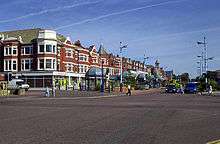
St Anne's-on-the-Sea (also known as St Annes-on-Sea or St Annes) was a 19th-century planned town, officially founded on 31 March 1875 when the cornerstone of the St Anne's Hotel was laid. The town was developed from 1875 after Thomas Fair, agent to the Clifton Estate, sold leases to the St Anne's on the Sea Land and Building Company. Plans for the town were laid out by the Bury firm of architects Maxwell and Tuke who later went on to construct Blackpool Tower. [9] It retains much of its original character today, and is fighting hard to become a stylish town to rival Lytham, its nearby neighbour. It is a traditional quiet Victorian/Edwardian seaside resort with up-market hotels, a sandy beach, a small pier, a statue of Les Dawson and ice cream stalls. Sand dunes fringe the beach and the town has an excellent, but little-known sand dune nature reserve and very good floral displays.
St Annes is the original home of Premium Bonds and their prize-selecting computer ERNIE, which were situated on a site between Shepherd Road and Heyhouses Lane. Premium Bonds operated from there for more than 40 years and then moved to Blackpool. The shopping area declined towards the end of the 20th century and was redeveloped in an attempt to attract more retailers and shoppers. As part of this project a restaurant quarter was established, centred around Wood Street. Work began on a £2m restoration project in Ashton Gardens, a park situated near the town centre. As this is where many of the activities for St Annes Carnival are held, the 2009 carnival was cancelled and the 2009 carnival queen's title was extended by one year.[10]
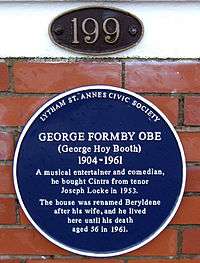
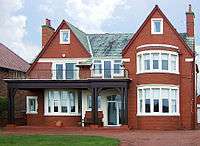
The beach to the north of St Anne's Pier was an internationally renowned sand yachting location for many years, but sand yachting has been suspended since 2002, when a visitor to the beach died after being hit by a sand yacht. St Annes Beach also hosts a number of kite flying events each year. In 2006 kite enthusiasts raised concerns about the future of these activities following a decision by Fylde Borough Council in 2006 to ban the flying of kites with two or more lines anywhere in the Fylde. Following representations from kite-fliers and completion of a risk assessment, the council rescinded the ban on condition that kite fliers remain at least 50m from the sand dunes. A memorial statue of a lifeboatman looking out to sea was placed on the promenade at St Annes after the Mexico Disaster of 1886. The original lifeboat station was established in 1881[11] but closed in 1925 due to silting of the channel (a secondary channel of the Ribble that ran past the pier). A lifeboat continued to operate from Lytham, but the main channel of the River Ribble also became silted up, so the lifeboat was moved to a new all-weather RNLI base a few hundred yards south of St Annes pier which opened in 2000.[12] St Annes-on-the-Sea Carnegie Library is situated just outside the town centre in an Edwardian, Carnegie-funded building.
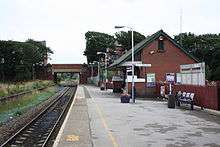
There is some confusion, even among residents of the town, about whether the correct name is "St Annes" or "St Anne's". The apostrophe has been dropped from the name by many of the residents of the town and has long been absent in many formal uses, such as local newspaper the Lytham St Annes Express,[13] St Annes Parish Church,[14] and Lytham St. Annes High Technology College, although the spelling St. Anne's is still sometimes used.[15]
On 23 October 2008 a bronze statue by sculptor Graham Ibbeson of comedian Les Dawson, who lived in the town, was unveiled by Dawson's widow and daughter in the ornamental gardens next to St Annes Pier.[16] Comedian George Formby, Jr. also lived in the town,[17] and has a plaque outside the house which he lived in from 1953 until his death in 1961.
St Annes is one of the few English towns whose centre was designed from the outset with a grid layout, albeit one which follows the curvature of the coast. Many principal streets are named after saints, such as St Annes Road West, the main shopping street, and St Annes Road East which is residential. The west/east demarcation is mostly according to the railway. The other axis consists of the two St Annes Roads. Roads which intersect either of these are named accordingly, for example St David's Road North and St David's Road South, St Andrew's Road North and St Andrew's Road South, St Patrick's Road North and St Patrick's Road South, North Promenade and South Promenade, Crosland Road North and Crosland Road South, Beverley Road North and Beverley Road South, and Clifton Drive North and Clifton Drive South. Roads from west-east that are named in this way include St Leonard's Road West and St Leonard's Road East, and Highbury Road West and Highbury Road East. Another lesser-known naming convention applies to back alleys, which are named after rivers, for example Tyne Street, Ribble Street, Avon Street, Tweed Street, Don Street and Goyt Street. Many of these streets no longer have properties in their own right, being used only for access to the rear of properties on neighbouring streets, and so many do not have name plates.
Ansdell
Ansdell is a small village between Lytham and St Annes, on the landward side of the railway line. It has its own railway station (shared with Fairhaven), the "Ansdell Institute" club and a public library. It is famous because of Richard Ansdell RA, an artist who lived in the area and painted numerous oils depicting hunting scenes. In fact, Ansdell enjoys the distinction of being the only place in England to be named after an artist.[18]
Ansdell hosts the largest school in Lancashire, Lytham St. Annes High Technology College, with over 2000 students, a dedicated technology and IT department, and an integrated A-Level College. Ansdell also encompasses the southern end of Royal Lytham & St Annes Golf Club. Ansdell is also the home of Fylde Rugby Club (FRC), established in May 1920, later to be closed during the war effort, and re-opened in 1946. FRC has reared many eminent players, notably Malcolm Phillips (a former President of the club) who earned 25 England caps, and Bill Beaumont who earned 34 caps before retiring in 1982. Woodlands Road, the Main Street in Ansdell hosts a variety of shops including a Co-op, St Paul's Charity Shop, Gails Hairdressers and Kelly's Newsagents. The selection of large Victorian houses on Commonside, Rossall Road and Ansdell Road North make the area an attractive alternative to Lytham, which is just over a mile away.
Fairhaven
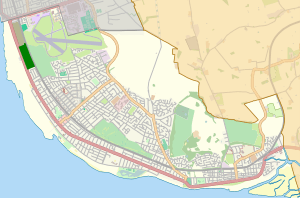
Fairhaven is the district between Lytham and St Annes on the coastal side of the railway line. It is named after Thomas Fair, an early resident of Lytham St Annes. Thomas Fair was the land agent of the Clifton estate. It is believed by other researchers Thomas Riley named his Master Plan for Fairhaven after the Bible passage Acts 27 verse 8 referring to Paul's journey to Rome. Many of the road names are connected to Paul and his journey. Its main claim to fame is an artificial lake, known as Fairhaven Lake or more formally as the Ashton Marine Park, which is an important wildfowl habitat. Its other famous landmark is the Fairhaven United Reformed Church, which is of unusual design, being built in Byzantine style and faced with glazed white tiles, and commonly known as the White Church. Fairhaven contains the former King Edward VII and Queen Mary School (KEQMS), which has now merged with Arnold School of Blackpool to become Arnold KEQMS (AKS). The sands and tidal mudflats of the area (the mouth of the River Ribble) are an important feeding area for wintering waders and the RSPB operate a visitor centre from Fairhaven Lake to provide information and guided walks. Fairhaven Lake has been flooded by the sea in the distant past but is now protected by a substantial sea defence wall.[19][20]
Fairhaven occupies an area of former sand dunes previously known as Starr Hills. This area extended as far as St Annes town centre along the southern side of the railway. The name Starr Hills is still used for a residential home named after the eponymous residence constructed in the 1860s for Richard Ansdell, which was transformed into a hospital during World War I,[21][22] before assuming its present use. The Fairhaven Estate was first laid out in 1892.[23] Beginning in 1895, the estate was divided into parcels of land which could be purchased or leased for residential development.[24]
History
The area is known to have been populated during the Bronze Age, and scattered hamlets have existed there ever since, including a village called Kilgrimol or Kilgrimhow, which is believed to have been founded in around 900 AD by Vikings expelled from Dublin.[25][26] The area including the Fylde was known in Anglo-Saxon and medieval times as Amounderness. Lytham is mentioned in the Domesday Book as Lidun. In 1199 Richard Fitzroger gave his Lytham estates (then known as Lethun) to the Benedictine monks of Durham. The monks established a priory (although it was really too small to be called that as it comprised three or four monks only) on the site of the present Lytham Hall. The priory existed until 1539; in 1540 the monastery at Durham was dissolved and the Crown became Lord of the Manor.[25]
The manor of Lytham passed through several owners until in 1606 it was sold to Cuthbert Clifton for £4,300.[27] Clifton enlarged the manor house and made it the family seat. The house was replaced in 1757 with the present Lytham Hall, designed by architect John Carr of York.[25] At this time St Annes did not exist, but Lytham was large enough to be called a town, with its own promenade and a reputation as a resort.[28]
Northwards along the coast from Lytham, within the Clifton estates, were mostly sand dunes. The only habitations were the tiny hamlet of Heyhouses and the rural Trawl Boat Inn (a name resurrected in recent times for a public house in Wood Street in St Annes, opened by Wetherspoons). In 1873 the Cliftons built a Chapel of Ease dedicated to St Anne in this area, to encourage better religious observance, as most inhabitants found the long journey to St Cuthbert's in Lytham too onerous. This became the parish church of St. Anne's. At the time it was built the church had no tower. On 14 October 1874 the St Anne's-on-the-Sea Land and Building Company Ltd was registered, mainly at the instigation of Elijah Hargreaves, a wealthy Lancashire mill owner from Rawtenstall whose intention was to develop the area as a resort. The land of St Annes was leased from the Clifton estate for 999 years, although the lease still gave the Cliftons the right to kill game on the land for this period. Building rapidly commenced with the St Anne's Hotel (built in 1875, since demolished), the Hydro Terrace, which later became St Annes Square, and the railway station being among the first buildings. A separate company was formed to finance the construction of the pier, which was opened on 15 June 1885. At that time the main channel of the River Ribble ran by the end of the pier, and boats would bring people in from Lytham and Southport. The Ribble Navigation Act of 1883, which came into force in 1889, was intended to stabilise the often silted River Ribble to allow a steady trade into Preston docks. However, this work moved the main channel much further out and left St Annes Pier on flat sandbanks, where no ships could dock. In June 1910 the Floral Hall was opened at the end of the pier. It was a popular attraction and stars including Gracie Fields, Leslie Henson and Claude Hulbert all performed there. In 1974 a major fire seriously damaged the hall. It was restored to some extent, it ended up being used as skatepark (skateboards) before another fire in July 1982 destroyed it. About half the pier was then demolished to make the beach safe to use.[29]
The Lytham St Annes Civic Society operates a local blue plaque scheme.[30] These commemorate historic buildings and residents, including Sir John Alcock and George Formby. The buildings commemorated are all still standing with the exception of the St Annes War Memorial Hospital, where a small housing estate now stands.
The 2012 Olympic torch relay passed through St Annes, Fairhaven and then Lytham before continuing onto nearby Warton and Freckleton.
Transport
Disability Access – Lytham town centre has limited disabled parking; Blue Badge holders take heed that if the disabled bays are already in use then parking in a non-disabled bay will require the purchase of a parking ticket or risk a parking fine. The town centre non-disabled bays are very narrow therefore getting in and out of the car may prove difficult for people with disabilities. There are other car parks outside the immediate town centre however these may be too far away for those with restricted mobility.
Railway

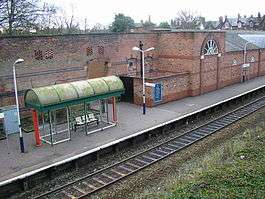
Lytham station, St Annes-on-the-Sea station and Ansdell & Fairhaven station all lie on the single track Blackpool South to Preston branch of the Blackpool Branch Lines. Prior to the closure of Blackpool Central in 1964 the Coast Road, as it was known, was the main line into Blackpool, although the Lytham St. Annes stations were bypassed by the direct line from Kirkham to Blackpool South. It has been reported that Central station in Blackpool could handle with ease one million people, in and out, in one day. Today the line is truncated at South station and the branch is operated euphemistically as "one engine in steam" but in fact is just a long siding from Kirkham. Trains run between Colne railway station and Blackpool South railway station on this line through Lytham St. Anne's.
Previously there were stations in Station Road, Lytham (1846–1874) and at Gillett's Crossing Halt near the Old Links Golf Course, St Annes (1913–1949).
Local issues
Lowther Pavilion Lytham
In 2008 local residents became aware that Fylde Borough Council was struggling financially, and in particular was becoming unable to subsidise local amenities. The closure of St. Annes swimming pool demonstrated how serious the situation was. It was felt that a group needed to take immediate action if they wished to reduce the subsidy from the council and ensure that Lowther Pavilion, the only purpose-built theatre in the area, remained open. In November 2008 Friends of Lowther Pavilion[31] was formed, with the stated purposes of reducing the subsidy required from the Council; securing the future of Lowther Pavilion, raising money for improvements, and ultimately generate profits; involving the local community in the running of the theatre and making it part of the town; and becoming the basis of a networking forum for the participating groups.
Closure of public facilities
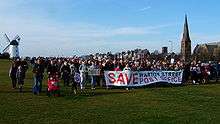
In 2008 Fylde Borough Council announced that the borough's two public swimming pools, in Kirkham and St Annes, would be closed. Public campaigns were started to oppose both closures. In April 2008 the council gave Kirkham Baths a one-year stay of execution, but St Annes swimming pool was closed. Supporters of the St Annes swimming pool have cited the lack of facilities for the town's children and young people, and the impact of the closure on the tourist industry. The discussion on St Annes pool continued; as of February 2010 Fylde Council had called for bids from firms to run the pool, and had received "All the bids from those wanting to run the pool".[32] The bid from Fylde Coast YMCA was accepted, and the pool re-opened on 1 September 2010.
A campaign against the planned closure of Warton Street Post Office, serving the eastern end of Lytham, met with more immediate success. In March 2008, the post office was removed from the national list of post offices scheduled for closure.
Property developments
As of 2007 the most controversial political issue in Lytham St Annes concerned property development. No more greenfield sites were available and developers were seeking to replace existing buildings or to build on open spaces such as Ashton Gardens in St Annes. Many historic buildings had been demolished and replaced with larger modern constructions of standard design as can be found in many other places. For example, the art deco former headquarters of the Football League was demolished and replaced with a block of flats. Fylde Rugby Club's ground and other open spaces have been built on.
In 2005 a property development company submitted a proposal for a 2,800 apartment development called Lytham Quays to be built on industrial brownfield sites in the east of Lytham; the proposal was rejected by the council's development control committee after 98.4% of the population voted against the development in a poll organised by the local press. In spite of this, the developer, Kensington Developments, still claimed in a 2008 article in the Daily Telegraph that "In truth, the majority of people were for it".[33] The "Defend Lytham" pressure group opposed the development. Objections included predictions of a loss of industrial land, increases in traffic congestion, and increased demands on local schools and health services. Environmental objections were also raised, given that the site is in an area prone to flooding and next to an important wildfowl habitat. The developers submitted a substantially smaller proposal for 260 dwellings which was approved in May 2006, and construction started.
In St Annes another group of developers succeeded in gaining planning permission to build a block of flats on the site of a derelict children's home in the sand dunes to the north of St Annes. This plan was resisted by local campaigners, as a result of which the council initially refused planning permission, but their decision was overturned on appeal to the Office of the Deputy Prime Minister, and building work was nearing completion by late 2007.
Wildlife
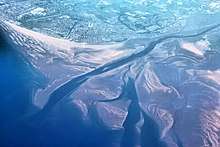
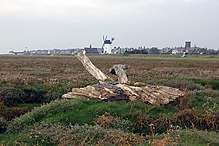
The Ribble Estuary and sands of St Annes and Lytham are an Important Bird Area, mainly as a feeding ground for waders during winter and spring.[34] There are flocks of thousands of red knot, dunlin, sanderling, bar-tailed godwit and other waders; over 100,000 birds winter there. Flocks of pink-footed geese are commonly seen in winter as they fly over St Annes between their feeding grounds around Southport and Over Wyre. Many pintail and other ducks feed and rest in the estuary.[34]
There are 80 hectares of sand dune habitat on the coast of Lytham St Annes which is home to a wide variety of rare and interesting plants and wildlife communities.[35] The Lytham St Annes Nature Reserve has around 250 different plant species include internationally rare plants not found outside the UK. Common lizards are found across the dune system and it is an important habitat for various breeding birds including stonechat, skylark, linnet and reed bunting. The grayling butterfly, which is a coastal specialist, is also found on the dunes.[36]
Witchwood is narrow strip of woodland that runs alongside the railway line, from Blackpool Road to Ballam Road. It was part of the original Lytham Hall parkland. The Lytham St. Annes Civic Society created the woodland walk by joining this area with land leased from British Rail, setting up a limited company to own and manage the wood. Society members cleared the undergrowth, removed rubbish and introduced a path running the length of the wood. The land is protected by a tree preservation order and part of it is a Site of Special Scientific Interest. Acting on advice from the Forestry Commission, invasive sycamore and elm are being replaced by indigenous English species such as oak, beech, ash, horse chestnut, birch and rowan. The walk, which was officially opened in 1974 by the Duke of Edinburgh, is a haven for wildlife and an important habitat for insects and birds.[37]
Culture
Art and architecture
The following organisations are currently active:-
- Lytham St Annes Art Society (founded 1912)
- Lytham St Annes Civic Society (founded c. 1955)
- Lytham Heritage Group
- Friends of the Lytham St Annes Art Collection
- Friends of Lytham Hall
- Fylde Arts Association
- Fylde Decorative and Fine Arts Society (Fylde DFAS)
A series of public artworks were commissioned as improvement works to The Square for Saint-Annes-on-the-Sea including a mosaic by artist Gary Drostle in 2005.
Music and entertainment
Notable musicians, actors and entertainers who were born or live(d) in Lytham St Annes include entertainer George Formby, comedians Les Dawson and Roy Walker, comedian and broadcaster Jenny Eclair, actors Stephen Tompkinson, Jonas Armstrong, Dean Lennox Kelly and Craig Kelly, composer Peter Dickinson, guitarist Mario Parga, drummer with Alien Sex Fiend and UFX/Uncle Fester Ratfink (Andrew Wilson), variety hall entertainer Betty Jumel, singer-songwriter Marli Harwood and Gigwise.com founder Andy Day.in 1999 Susan Swindells (now Susan wood) created the idea for the Lytham Proms Festival and with funding from bae systems ‘the Lytham Proms Festival was borne. The Festival was created for the local community raise funds for charity and boost Fylde Coast tourism.
Festivals
Beer Festival
Lytham Beer Festival has been held annually in September since 2007, although this was moved to October in 2012. It is organised by the Blackpool, Fylde and Wyre branch of CAMRA and offers a choice of around 90 real ales as well as a selection of ciders and foreign bottled beers.[38]
Lytham Proms Festival (1999–2014)
In 1999 local resident, Susan Swindells (now Susan Wood), came up with the idea for a traditional proms festival event to be held on Lytham Green. She then took her idea to her employers, British Aerospace, who decided to both fund and stage the idea. The first ever Proms event took place on 11 July 1999. Despite suffering from hearing loss, Swindells' idea was for a Fylde Coast music festival which would bring the community together, raise money for charity and boost tourism. The 1999 event included performances by Northern Chamber Orchestra, soprano Joan Aitchison, Lytham St Annes Choral Society led by conductor Andrew Barratt, Freckleton Brass Band led by Paul Dalton, and compered by Eric Knowles. The event attracted an audience of over 4,000 people on its first night and raised funds for the Royal National Institute for the Deaf and Leukaemia Research. After the success of the first event, in 2000 Fylde Council staged a second year's event. Subsequent shows were organised by Performing Arts Management headed by Nicholas Smith and Sally Smith.
In 2009 Daniel Cuffe and Peter Taylor took over with a one-night concert by Lesley Garrett, but since then the concert has grown into a three-night festival with such performers as Olly Murs, Status Quo, Katherine Jenkins, Boyzone, Alfie Boe, Toyah Willcox, Bananarama, Rick Astley, Belinda Carlisle, T'Pau and the Real Thing. The 2013 line-up included Russell Watson, Jason Donovan, Sonia and Rita Ora.[39]
The headline act for the 2014 event was Tom Jones, with support from Cerys Matthews.[40] The opening night, on Friday 1 August, was billed as "The '80s versus the '90s", and featured ABC, Blue, Hue and Cry, Atomic Kitten, the Christians, Captain Sensible, Heather Small, Howard Jones, B*Witched, China Crisis and Brother Beyond. The final day featured the Halle Orchestra, Michael Ball, Lesley Garrett and Rhydian Roberts.[41]
Lytham Festival
In 2015 this event ran as a week long event under the name Lytham Festival.[42]
Lytham 1940s Weekend
Lytham 1940s Weekend which takes place at the beginning of August takes place on Lytham Green with historical re-enactment, WWII vehicles on display, antique stalls and information stands from various organisations.
Sport
The Royal Lytham & St Annes Golf Club was founded in March 1886 and moved to its present site in 1926. Many world tournaments have been, and are, played there, including the Ryder Cup, the Open Championship and the Dunlop Cup. The clubhouse is situated on Links Gate and the course runs southwards as far as Ansdell, adjacent to the railway line.
Lytham Green Drive Golf Club was founded in 1913 and registered as "Lytham Golf Club Ltd.", opened with a match on Saturday 3 May, between the Captain, Mr. James Wallace and the President and Landlord, Mr. J. T. Clifton, which was played over nine holes. The course became 18 holes in early 1914. It hosted qualifying for Open Championship in 1974, 1979 and 1988. The clubhouse is situated on Ballam Road, a little over half a mile from the centre of Lytham. The course runs adjacent to the scenic walk of Green Drive.
There are two other golf clubs in the area, which have all hosted qualifying for The Open Championship. They are Fairhaven Golf Club and perhaps the most well known, St Annes Old Links Golf Club, which has also hosted many other top events in the golfing calendar. The Old Links course runs northwards from Highbury Road on the landward side of the railway line.[43]
Fylde Rugby Club, who compete in English National League one, play at the Woodlands Memorial Ground, which is shared with Blackpool Rugby League Club, who compete in National League Two. Amongst their notable players are two British and Irish Lions, Bill Beaumont and Brian Ashton.
The headquarters of the English Football League were re-located to the former Sandown Hotel in Clifton Drive in St Annes in 1959, having previously been situated in Preston, Lancashire, where they are now once again.
St Annes Cricket Club are based at Vernon Road, St Annes. England and Lancashire cricketer Andrew Flintoff played for St Annes, starting as a 12-year-old in 1989.[44]
Lytham Cricket and Sports Club is based in Church Road, Lytham. It is the home of Lytham St Annes Hockey Club[45] and also provides facilities for cricket, tennis and football.
Fylde Triathlon Club was formed following the success of the annual St Annes Triathlon that is held in May at St Annes Swimming pool. In 2009 the club is also organising a triathlon in Fleetwood.
St Annes Tennis and Squash Club is based on Avondale Road, St Annes, just off Clifton Drive. It is the home of six men's teams, three women's teams and four junior teams that all compete in the competitive Fylde Tennis Leagues. The club has nine tennis courts and three squash courts.
Health care
Primary care is the responsibility of NHS North Lancashire Primary Care Trust.
There have been a number of recent reorganisations and building for general practice in the area.
General practice in Lytham is based at a health centre opened in 2009 called the Lytham Primary Care Centre. This building is on the site of the original Lytham Hospital. Two practices are located in this building
Secondary care is mainly provided by the Blackpool, Fylde and Wyre Hospitals NHS Foundation Trust[48]
The local hospital included in the Blackpool, Fylde and Wyre Hospitals NHS Foundation Trust include
- Main acute hospital: Blackpool Victoria Hospital
- Two community hospitals – Clifton Hospital and Fleetwood Hospital
- Two elderly rehabilitation hospitals – Rossall Hospital Rehabilitation Unit and Bispham Hospital
- The National Artificial Eye Service
- Blenheim House Child Development Centre
Religion
Lytham
- Lytham Methodist Church, Park Street; opened in September 1868
- St Cuthbert's (Church of England), Church Road; built in 1834.[49]
- St John the Divine Church (Church of England), East Beach; built 1848–49 by Edwin Hugh Shellard.[50][51]
- St Peter's Roman Catholic Church, Clifton Street; built 1838, the tower was added in 1878.[52]
- Lytham Christian Centre, Preston Road[53]
- Lytham United Reformed Church, Bannister Street; founded 1863.[54]
St Annes
- Church Road Methodist Church, Church Road.[55]
- St Anne's Church, Church of England parish church, Oxford Road – built in 1873 by Paley and Austin. The tower was added in 1887.[56]
- St Annes Baptist Church, St.Andrews Road South – opened on Christmas Day 1886.[57]
- St Annes on Sea United Reformed Church, Clifton Drive – built by W.J. Porritt from 1880 onwards.[58]
- St Annes Hebrew Congregation, Orchard Road[59]
- Our Lady Star of the Sea Church, Roman Catholic church, St Annes Road East, built in 1890 by Pugin & Pugin.[60]
- St Thomas' Church, St Thomas Road – built in 1899 by Austin and Paley.[61]
- Fylde Christian Service Church, St.Andrews Road South – based in the former St Annes Baptist chapel[62]
- St Margaret of Antioch, St.Leonards Road West – founded in 1925[63]
- St Alban RC Church, Kilnhouse Lane – founded in 1964.[64]
- St. Gregory's Eastern Orthodox Chapel, Orchard Road - established in 2017.[65]
Ansdell and Fairhaven
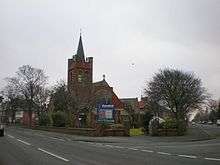
- Ansdell Baptist Church, Ansdell Road North; founded 1908[66]
- Ansdell Unitarian & Free Christian Church, Channing Road; opened 1930, new hall added 1968.
- St Joseph's RC Church, Woodlands Road; opened 20 September 1914; built 1909 by Pugin & Pugin
- Fairhaven United Reformed Church, Clifton Drive South; opened 17 October 1912; built by Briggs, Wolstenholme & Thornley; known locally as the "White Church".
- St Paul's CofE Church, Clifton Drive; built 1902 by Medland Taylor.[67]
- Fairhaven Methodist Church, Clifton Drive; founded 1909.[68]
Twin towns/Sister cities
Lytham St Annes is twinned with:
See also
- Listed buildings in Lytham
- Listed buildings in Saint Anne's on the Sea
- John Talbot Clifton (1819–1882) of Lytham Hall – MP for North Lancashire
- John Talbot Clifton (1868–1928) of Lytham Hall – traveller
- Violet Clifton (1883–1961) of Lytham Hall – traveller and writer.
- Larry L'Estrange (1934–2007), born in Lytham – Irish rugby player and British soldier.
Notes
- G.M. Miller, BBC Pronouncing Dictionary of British Names (London: Oxford University Press, 1971), p. 93.
- "Lytham St Anne's (Lancashire, North West England, United Kingdom) - Population Statistics and Location in Maps and Charts". Citypopulation.de. Retrieved 27 July 2016.
- Average Gross Household Income by Wards 2006. Archived 1 June 2011 at the Wayback Machine
- McKie, David (6 September 2007). "Around the culs-de-sac". The Guardian. London. Retrieved 12 May 2010.
- "Home - Lancashire County Council". Lancashire.gov.uk. Retrieved 27 July 2016.
- "About Us". Lytham Brewery. Lytham Brewery. August 2013. Retrieved 14 August 2013.
- Christopher Thomond (13 August 2013). "Eyewitness: Lytham, Lancashire" (Image upload). The Guardian. Retrieved 14 August 2013.
- "Final chapter for Lytham and Freckleton libraries".
- P.Shakeshaft, St Anne's on the Sea: A History, (Carnegie: Lancaster,2008), 141-164
- "St Annes Carnival cancelled this year". Lytham St Annes Express. Retrieved 27 July 2016.
- "Archived copy". Archived from the original on 25 September 2006. Retrieved 5 April 2007.CS1 maint: archived copy as title (link)
- "Archived copy". Archived from the original on 5 February 2007. Retrieved 5 April 2007.CS1 maint: archived copy as title (link)
- "Lytham St Annes Express Lytham Today". Lytham St Annes Express. Retrieved 23 September 2007.
- "St Annes Parish Church, St Annes". St Annes Parish Church. Retrieved 23 September 2007.
- "Lytham St. Annes High Technology College". Lytham St. Annes High Technology College. Archived from the original on 29 September 2007. Retrieved 23 September 2007.
- "Dawson statue unveiled by family". bbc.co.uk. 23 October 2008. Retrieved 13 November 2008.
- George, Gerry. "Gerry George's Memories". whirligig-tv. Retrieved 28 December 2008.
- 'Treasures to be put on display at gallery', Blackpool Gazette, 28 December 2006
- "Archived copy". Archived from the original on 30 September 2007. Retrieved 10 April 2007.CS1 maint: archived copy as title (link)
- "Archived copy". Archived from the original on 30 September 2007. Retrieved 10 April 2007.CS1 maint: archived copy as title (link)
- "Archived copy". Archived from the original on 3 March 2012. Retrieved 17 December 2011.CS1 maint: archived copy as title (link)
- "Lytham & St.Annes on the Sea Lancashire - Local History - Starr Hills Hospital, Ansdell, 1916". Amounderness.co.uk. Retrieved 27 July 2016.
- "Lytham & St.Annes on the Sea Lancashire - Local History - Fairhaven Estate". Amounderness.co.uk. Retrieved 27 July 2016.
- "Lytham & St.Annes on the Sea Lancashire - Local History - Fairhaven Estate Company 1895". Amounderness.co.uk. Retrieved 27 July 2016.
- "Archived copy". Archived from the original on 27 February 2009. Retrieved 23 January 2009.CS1 maint: archived copy as title (link)
- Lancastriensis, Notes and Queries, 2nd ser. vol. 7, January–June 1859, p. 56
- Henry Fishwick, The History of the Parish of Lytham in the County of Lancaster, Chetham Society New Series 60 (1907), p. 18
- Transactions of the Historic Society of Lancashire and Cheshire 1993, p. 162.
- Harrison (1971)
- "Blue Plaques". Lytham St Annes Civic Society. Archived from the original on 26 August 2014. Retrieved 10 August 2014.
- "Lowther Pavilion - Fylde Coast". Friendsoflowtherpavilion.co.uk. Archived from the original on 25 August 2010. Retrieved 27 July 2016.
- "Kirkham Baths | Simon Renwick". Simonrenwick.wordpress.com. Retrieved 27 July 2016.
- "Archived copy". Archived from the original on 9 February 2008. Retrieved 9 February 2008.CS1 maint: archived copy as title (link)
- "UK057: Ribble and Alt Estuaries". BirdLife International. Retrieved 24 June 2013.
- "Sand Dunes". Fylde Borough Council. Retrieved 24 June 2013.
- Ellis, Sam; Bourn, Nigel (2000). "Regional Action Plan North West England" (PDF). Butterfly Conservation: 42. Retrieved 24 June 2013. Cite journal requires
|journal=(help) - "Archived copy". Archived from the original on 16 April 2015. Retrieved 11 April 2015.CS1 maint: archived copy as title (link)
- "Blackpool Fylde and Wyre CAMRA". Archived from the original on 7 September 2010. Retrieved 10 March 2011.
- Lytham Festival. "Lytham Festival | Home". Lythamproms.co.uk. Retrieved 27 July 2016.
- "Sir Tom Jones to headline Lytham Proms". BBC News. Retrieved 27 July 2016.
- Lytham Proms Magazine (2014), published by www.lythamproms.co.uk, p.9
- "Lytham Festival featuring Noel Gallagher's High Flying Birds". tickets.amazon.co.uk. Retrieved 9 June 2017.
- "Home :: St Annes Old Links Golf Club". Stannesoldlinks.com. 20 July 2016. Retrieved 27 July 2016.
- "Archived copy". Archived from the original on 13 May 2007. Retrieved 22 May 2007.CS1 maint: archived copy as title (link)
- "Lytham St. Annes Hockey Club". Lsahc.co.uk. Retrieved 27 July 2016.
- "Lytham Primary Care Centre, Victoria Street, Lytham, FY8 5DZ | Telephone: 01253 955350Holland House Surgery". Holland House Surgery. 16 February 2016. Retrieved 27 July 2016.
- "Lytham Primary Care Centre and Freckleton Health CentreFernbank Surgery". Fernbank Surgery. 16 February 2016. Retrieved 27 July 2016.
- "Blackpool Teaching Hospitals NHS Foundation Trust | Together we care". Bfwhospitals.nhs.uk. 20 June 2014. Retrieved 27 July 2016.
- "Lytham, St Cuthbert, Church of England, Lancashire". GENUKI. 1 May 2016. Retrieved 27 July 2016.
- "St John the Divine, Lytham, Lancashire". GENUKI. 1 May 2016. Retrieved 27 July 2016.
- "Archived copy". Archived from the original on 6 December 2013. Retrieved 12 March 2013.CS1 maint: archived copy as title (link)
- "St Peters Catholic Church Lytham". Stpetersoflytham.org.uk. Retrieved 27 July 2016.
- "Mount Olivet Pentecostal, Lytham, Lancashire". GENUKI. 1 May 2016. Retrieved 27 July 2016.
- "Bannister St Congregational, Lytham, Lancashire". GENUKI. 1 May 2016. Retrieved 27 July 2016.
- "Church Rd Methodist". Churchroadmethodist.org. Retrieved 27 July 2016.
- "St Annes Parish Church, St Annes on Sea – Welcome to Our Church". Stannesparishchurch.org. 27 November 2013. Retrieved 11 January 2014.
- "Home – St Annes Baptist Church". Stannesbaptist.org. 5 January 2014. Retrieved 11 January 2014.
- "St. Annes on Sea United Reformed Church:". Stannesurc.org.uk. Retrieved 11 January 2014.
- "JCR-UK: St. Annes Hebrew Congregation, Lytham St. Anne's, Lancashire, England". Jewishgen.org. Retrieved 27 July 2016.
- "Our Lady Star of the Sea Roman Catholic Church, Lytham St. Annes". Ourladystarofthesea.co.uk. Archived from the original on 11 January 2014. Retrieved 11 January 2014.
- "St Thomas Church of England, St Annes, Lancashire". GENUKI. 1 May 2016. Retrieved 27 July 2016.
- "Fylde Christian Service Church". Fcsc.info. 30 March 2008. Retrieved 11 January 2014.
- "St Margaret of Antioch Church of England, St Annes, Lancashire". GENUKI. 1 May 2016. Retrieved 27 July 2016.
- "St Alban Roman Catholic, St Annes, Lancashire". GENUKI. 1 May 2016. Retrieved 27 July 2016.
- "Romanian Orthodox Metropolitanate of Western and Southern Europe - OrthodoxWiki". orthodoxwiki.org. Retrieved 26 June 2019.
- "Blackpool Rd Baptist, Ansdell, Lancashire". GENUKI. 1 May 2016. Retrieved 27 July 2016.
- "St Paul Church of England, Ansdell, Lancashire". GENUKI. Retrieved 27 July 2016.
- "Clifton Drive Methodist, Fairhaven, Lancashire". GENUKI. 1 May 2016. Retrieved 27 July 2016.
- "Twin Towns". Lytham St Annes Twinning Association. Retrieved 3 May 2019.
References
- Harrison, Gabriel (1971) Rage of Sand: the story of the men who built their own seaside town, London : Benn, ISBN 0-510-27118-9
- Pevsner, Nikolaus (1969) The Buildings of England – North Lancashire, Penguin, ISBN 0-14-071037-X.
External links
| Wikimedia Commons has media related to Lytham St Annes. |
| Wikivoyage has a travel guide for Lytham. |
- http://www.lythamstannes.news Lytham St Anne's News
- https://www.visitlytham.info Local information
- https://www.visitStAnnes.info Local information
.svg.png)